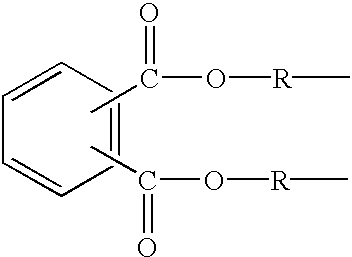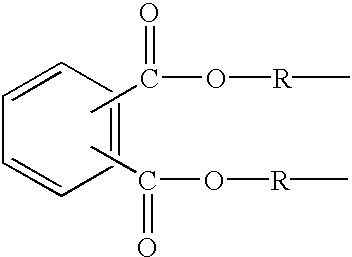Controlled release formulations and methods for their production and use
a technology of release formulation and release method, applied in the field of controlled, can solve the problems of inefficient use, ineffective targeting of pesticides, and unacceptable exposure of farmers, applicators, and nearby residents to pesticides
- Summary
- Abstract
- Description
- Claims
- Application Information
AI Technical Summary
Problems solved by technology
Method used
Image
Examples
example 2
[0139] This illustrates the preparation of the controlled release formulation with tebuconazole at several loading levels and with the use several different matrix polymers and matrix polymer plasticizers.
[0140] Microparticles of the subject controlled release formulation were prepared by the same method as described in Example 1, except that PMMA having different molecular weights, and poly(styrene-co-maleic anhydride) (PSMA) were substituted for the matrix polymer and poly(vinyl acetate) was substituted for the plasticizer. Microparticles from these various formulations had the properties shown in Table 1.
1TABLE 1 Composition of controlled release formulations with tebuconazole. SUSPENSION NO. 1 2 3 4 5 6 7 ACTIVE 40% 40% 40% 40% 40% 40% 40% INGREDIENT LEVEL.sup.a Tebuconazole.sup.b 6.44 6.44 6.78 7.23 6.92 7.04 LOADING (gm) PMMA 350,000 MW.sup.c 6.8 6.8 5.16 ---- -- --(gm) PMMA 120,000 MW.sup.c -- -- -- 8.04 5.48 ----(gm) PSMA.sup.d(gm) -- -- -- -- -- 7.3 7.43 Poly(vinyl acetate)...
example 3
[0141] This example illustrates the preparation of microparticles containing tebuconazole at 40% loading with several combinations of matrix polymer and matrix polymer plasticizer.
[0142] Microparticles of the subject controlled release formulation were prepared by same method as described in Example 1, except that a number of different combinations of matrix polymer (PMMA, PSMA, and poly(butyl methacrylate) MA)), and matrix polymer plasticizer (poly(vinyl acetate) (PVA), phthalic anhydride (PA), dibutyl phthalate (DBP) were tested. Microparticles from these various formulations had the properties shown in Table 2.
2TABLE 2 Properties of tebuconazole blend formulations at 40% by weight tebuconazole loading. MATRIX MP:MPP PARTICLE TEST POLYMER PLASTICIZER WEIGHT REA SIZE % NO. (MP) (MPP) RATIO % (microns) ACTIVE.sup.a COMMENTS 1 PMMA PVA 90:10 -- -- -- Failed; crystals 350 formed 2 PMMA PVA 70:30 -- -- -- Failed; soft 350 cake 3 PMMA PA 90:10 -- -- -- Failed; bad 350 capsules 4 PMMA PA...
example 4
[0143] This illustrates the control of the release rate of tebuconazole into water from controlled release microparticles of several different compositions by selection of the matrix polymer and matrix polymer plasticizer and the amount of the plasticizer.
[0144] The release rate of tebuconazole was tested for controlled release formulations that were produced in Example 3, test numbers 7, 10, 11 and 30, by mixing an amount of the formulation with water at room temperature so that the total concentration of active ingredient present in the aqueous mixture is no more than about 1 / 3 of the solubility limit of the active in water at room temperature--about 25.degree. C. The mixture is then mixed in a beaker with a magnetic stirrer. At intervals, aliquots of the mixture are removed and filtered through a 0.45 micron PTFE filter. The amount of the active ingredient in the filtered solution is then measured. For example, when the active ingredient is tebuconazole, about 8 ppm total concent...
PUM
| Property | Measurement | Unit |
|---|---|---|
| melting point | aaaaa | aaaaa |
| size | aaaaa | aaaaa |
| size | aaaaa | aaaaa |
Abstract
Description
Claims
Application Information
 Login to View More
Login to View More - R&D
- Intellectual Property
- Life Sciences
- Materials
- Tech Scout
- Unparalleled Data Quality
- Higher Quality Content
- 60% Fewer Hallucinations
Browse by: Latest US Patents, China's latest patents, Technical Efficacy Thesaurus, Application Domain, Technology Topic, Popular Technical Reports.
© 2025 PatSnap. All rights reserved.Legal|Privacy policy|Modern Slavery Act Transparency Statement|Sitemap|About US| Contact US: help@patsnap.com



